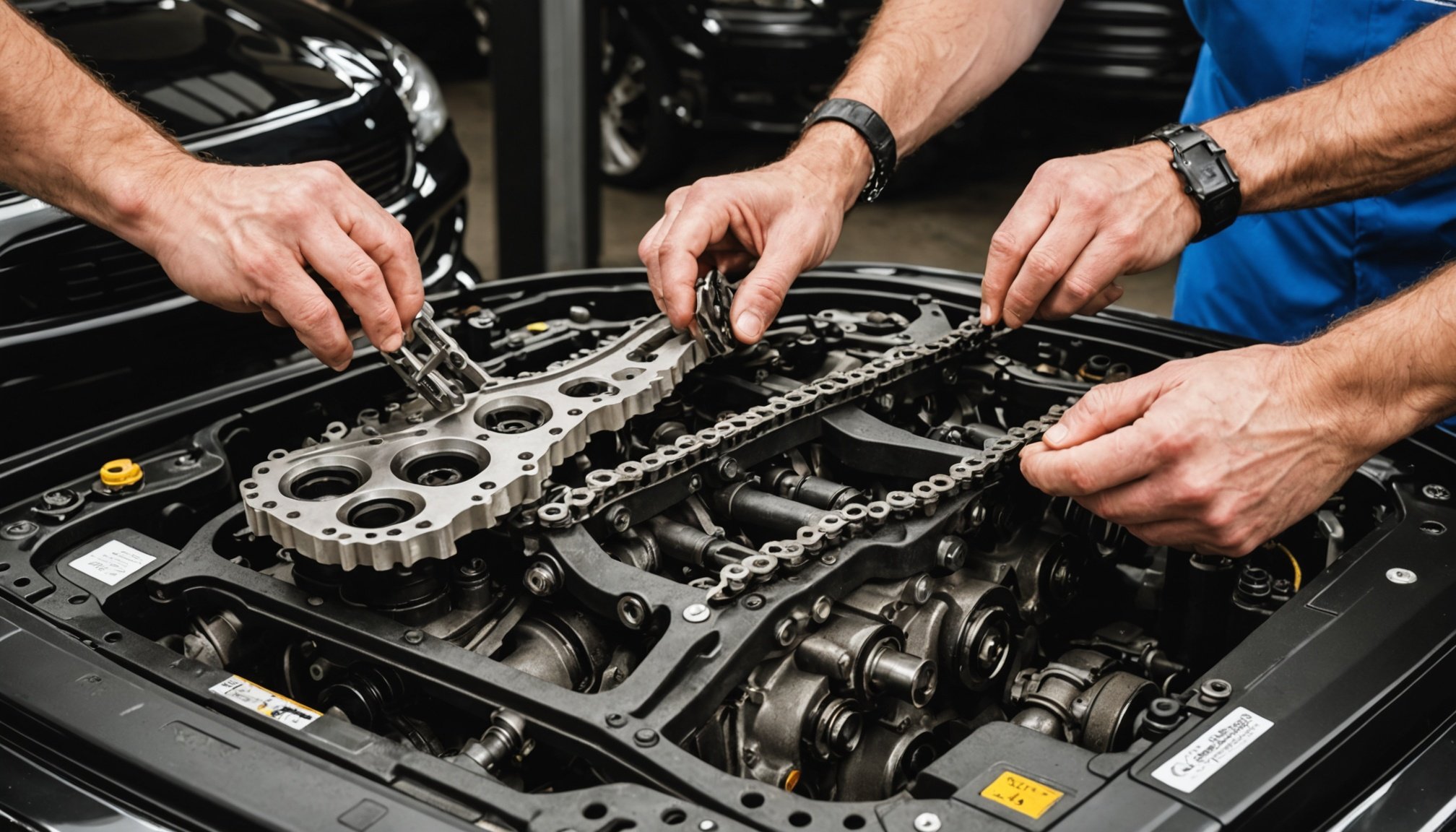Understanding Timing Chains in High-Performance Cars
The timing chain plays a crucial role in the operation of high-performance vehicles. As an integral component of the engine, it synchronises the rotation of the crankshaft and camshaft. This ensures that the engine’s valves open and close at precise intervals during each cylinder’s intake and exhaust strokes. In contrast to timing belts, which are made from rubber and prone to wear, timing chains are crafted from metal, making them more durable and better suited for high-stress environments.
Timing chains are particularly important in high-performance UK cars, where engine reliability and longevity are paramount. Performance engines often produce higher stress and demand a robust method of maintaining engine timing integrity. A key advantage of timing chains over belts is their ability to handle more power and torque, which is often present in these vehicles.
Also read : Comprehensive Guide to Testing and Replacing Timing Chains in High-Performance UK Cars
Moreover, the life span of timing chains is significantly longer, which reduces the frequency of replacement and maintenance costs. While timing chains require less frequent attention, they should still be inspected periodically for signs of wear or tension issues to ensure optimal performance. Understanding the mechanics of timing chains can be a boon for enthusiasts and mechanics alike, aiding in maintaining the high standards expected of performance cars.
Testing Timing Chains
Understanding the performance of timing chains is critical to car maintenance. To ensure efficient diagnostics and maintenance, specific methods can be employed to test the condition of these components. One reliable approach involves inspecting the timing chain for slack or elongation, as these are common indicators of wear. Utilizing specialized tools such as a tension gauge can help identify if the chain has exceeded its service limits.
Also to discover : Mastering Tire Rotation for Four-Wheel Drives: A Guide to Even Wear and Enhanced Safety
In some cases, audio tests can be diagnostic. Unusual noises coming from the engine, like rattling, can signify a worn timing chain. Additionally, difficulty starting the engine or misfiring might point to timing issues, which necessitates further evaluation.
For a thorough examination, use tools like timing lights or diagnostic scanners that can offer real-time engine data. These tools provide critical insights into the chain’s alignment and function. Noticing signs early, like reduced engine performance or increased emissions, can prevent catastrophic failures. Implementing a routine testing schedule is advisable to extend the lifespan of your vehicle’s engine components.
By conducting regular diagnostic checks and using appropriate tools, you can maintain robust engine performance while avoiding costly repairs.
Replacing Timing Chains
Replacing a timing chain is a critical task for maintaining engine health. Guiding you through the process ensures accuracy and safety.
Preparation for Replacement
Before you begin replacing timing chains, gather necessary tools — including wrenches, screwdrivers, and a timing light. Make sure the vehicle has cooled down to prevent injuries. Elevate the car securely and ensure you have the new timing chain, tensioners, and guides ready.
Step-by-Step Replacement Guide
- Remove engine covers: Unbolt and carefully lift the engine covers for access.
- Detension the old chain: Release the tensioner and detach the old chain.
- Install the new chain: Align the new chain according to the engine marks to maintain timing.
- Fit new tensioners and guides, ensuring they engage correctly.
Post-Replacement Checks
Turn the crankshaft manually to ensure the new chain is properly seated without any kinks. Listen for any unusual noises indicating a misalignment or tension error. Start the engine and observe for smooth operation, verifying timing integrity.
Necessary Tools for Timing Chain Replacement
Prior to embarking on a timing chain replacement, it is crucial to gather the essential tools specifically designed for this task. Having the correct automotive tools not only streamlines the process but also ensures precision and prevents damage.
When considering the tools for timing chain replacement, your toolkit should include a timing chain tensioner tool, crankshaft pulley holder, and a camshaft alignment tool. These specialised tools ensure the components are aligned accurately, reducing the likelihood of error during installation. Quality automotive tools are crucial as they withstand the demands of engine work and provide the accuracy your vehicle requires.
Selecting the right tools is more than just about what’s available—consider the fit and compatibility with your specific vehicle model. Investing in high-quality tools can prevent mishaps such as slippage, which could potentially damage engine components. Therefore, ensure that these tools meet industry standards, providing durability and reliability.
Ultimately, having a comprehensive and quality toolkit is indispensable for a successful timing chain replacement. By prioritising precision with the right automotive tools, you safeguard against unnecessary complications and uphold the longevity and performance of your engine.
Common Issues with Timing Chains in High-Performance Cars
Timing chain issues in high-performance cars can pose significant challenges for enthusiasts and mechanics alike. These issues often emerge from the high stress and increased engine demands these vehicles undergo. Problems such as chain stretch, tensioner failure, and guide wear are particularly common. Chain stretch can lead to erratic engine behaviour and misalignment of engine timing, impacting overall performance.
Troubleshooting these issues effectively requires a keen eye and an understanding of the symptoms. Listening for unusual rattling noises, especially during engine start-up, can be the first sign of a timing chain issue. Visual inspections might reveal wear and tear on the chain itself or associated components like the tensioner and guides.
Preventative maintenance is key to avoiding timing chain problems in high-performance vehicles. Regularly checking oil levels and quality can significantly reduce chain wear, as proper lubrication is crucial. Scheduling routine inspections with a professional can also help catch early signs of potential failures. Additionally, manufacturers often provide specific service intervals for timing chain inspection or replacement, which should be adhered to for optimal longevity and performance. Keeping these maintenance tips in mind will help ensure your performance car operates smoothly and efficiently.
Timing Chains vs. Timing Belts
In the realm of automotive engineering, understanding the distinction between timing chains and timing belts is essential. These components are critical for synchronising the crankshaft and camshaft, but they possess inherent differences that affect vehicle performance.
Timing chains, known for their durability, typically require less frequent replacement compared to timing belts. They are often perceived as a more reliable option for high-performance engines. The metal composition of timing chains enhances longevity, reducing maintenance frequencies and thereby providing cost-effectiveness over time. However, they can be noisier and heavier than belts.
In contrast, timing belts are lighter and operate more quietly. Their materials, generally made of reinforced rubber, facilitate smoother engine operation. Performance comparison clearly shows that timing belts offer advantages in quieter operation, but necessitate periodic replacements. This maintenance is crucial to prevent potential damage to the engine if the belt breaks.
A comparative analysis highlights how the choice between timing chains and belts impacts the engine’s efficiency and upkeep. Automotive enthusiasts must weigh the long-term cost-effectiveness and longevity considerations when deciding which is more suitable for their vehicle’s needs, especially in high-performance contexts where reliability and maintenance intervals are vital.
Conclusion
Maintaining a timing chain is crucial for ensuring the longevity of a high-performance car. The timing chain’s primary function is to synchronize the camshaft and crankshaft’s rotation, ensuring the engine’s valves open and close at the right times during each cylinder’s intake and exhaust strokes. Proper automotive care ensures your car runs smoothly and helps prevent inevitable wear and tear.
Regular check-ups and servicing are essential for high-performance car maintenance. Pay attention to any unusual noises coming from the engine, as they might indicate a need for timing chain inspection or replacement. Utilizing a trusted timing chains guide can be advantageous in diagnosing potential issues early. Regular oil changes help keep the timing chain lubricated and functioning optimally, an often overlooked aspect of car maintenance.
For those seeking more detailed and technical assistance in automotive care, numerous resources are available. Mechanical workshops are equipped with specialists familiar with complex car engines. Online resources also provide in-depth articles and tutorials for enthusiasts looking to deepen their understanding. Always remember, proactive care today saves costly repairs tomorrow.










